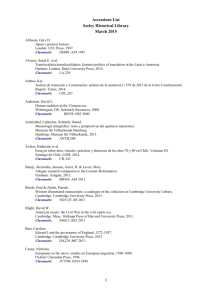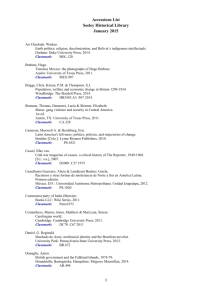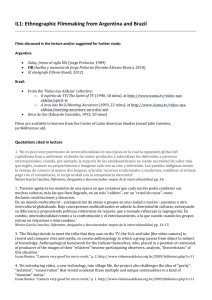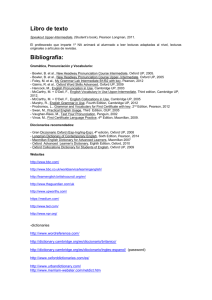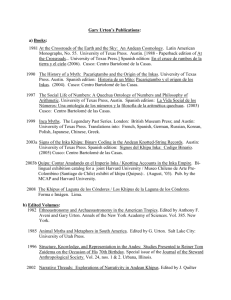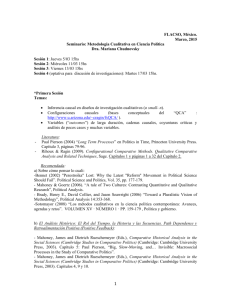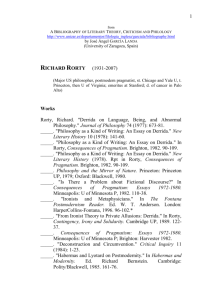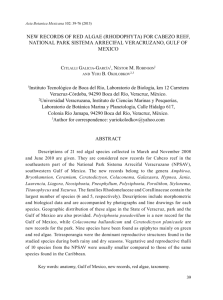Dra. Conforti: - Universidad de Buenos Aires
advertisement
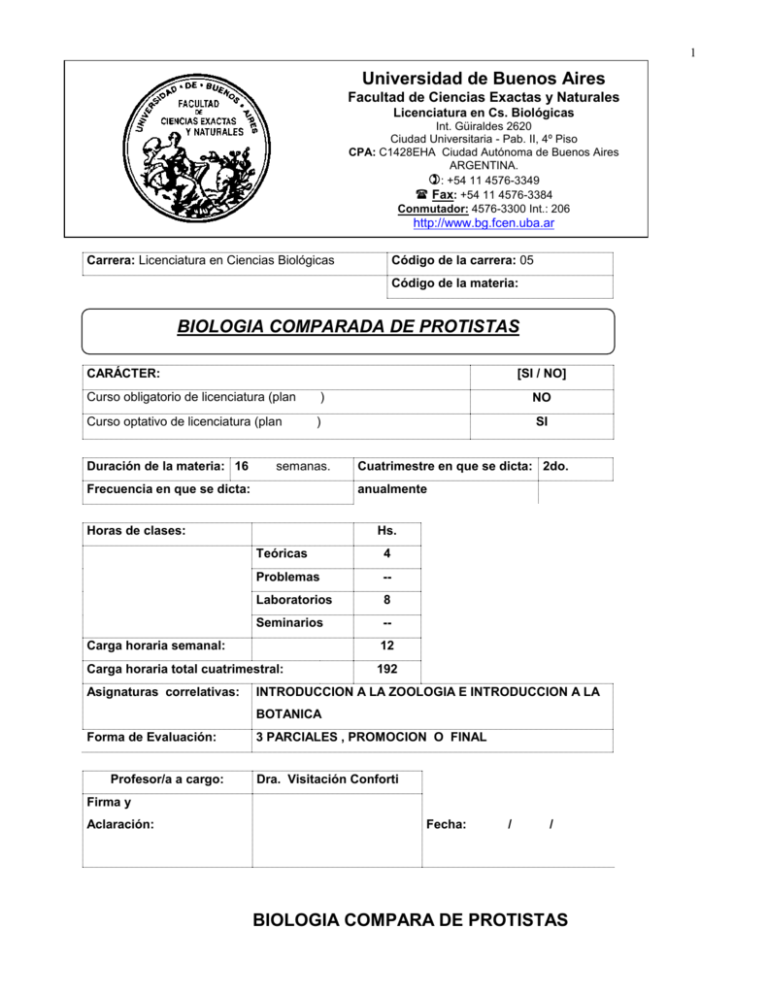
1 Universidad de Buenos Aires Facultad de Ciencias Exactas y Naturales Licenciatura en Cs. Biológicas Int. Güiraldes 2620 Ciudad Universitaria - Pab. II, 4º Piso CPA: C1428EHA Ciudad Autónoma de Buenos Aires ARGENTINA. : +54 11 4576-3349 Fax: +54 11 4576-3384 Conmutador: 4576-3300 Int.: 206 http://www.bg.fcen.uba.ar Carrera: Licenciatura en Ciencias Biológicas Código de la carrera: 05 Código de la materia: BIOLOGIA COMPARADA DE PROTISTAS CARÁCTER: [SI / NO] Curso obligatorio de licenciatura (plan ) NO Curso optativo de licenciatura (plan ) SI Duración de la materia: 16 semanas. Frecuencia en que se dicta: Cuatrimestre en que se dicta: 2do. anualmente Horas de clases: Hs. Teóricas 4 Problemas -- Laboratorios 8 Seminarios -- Carga horaria semanal: 12 Carga horaria total cuatrimestral: 192 Asignaturas correlativas: INTRODUCCION A LA ZOOLOGIA E INTRODUCCION A LA BOTANICA Forma de Evaluación: Profesor/a a cargo: 3 PARCIALES , PROMOCION O FINAL Dra. Visitación Conforti Firma y Aclaración: Fecha: / / BIOLOGIA COMPARA DE PROTISTAS 2 PROGRAMA TEORICO Introducción. I. Origen del Reino Protista. Problemas con su taxonomía y filogenia. Diferentes tipos de clasificaciones. Taxonomía ambirreinal. Morfología comparada. II. Principales tipos de estructuras corticales. Diferenciaciones de la membrana. Extrusomas. Escamas y espículas. Lórigas, quistes y tecas. Esqueletos internos. Ultraestructura de la cilia y el flagelo. Citoesqueleto. Sistemas de microfilamentos y microtúbulos. III. Endoplasma. Particularidades del retículo endoplasmático y del aparato de Golgi. Particularidades del condrioma. Peroxisomas. Microcuerpos. Particularidades de los plástidos. Tipos de pirenoides. Tipos de estigmas. Vacuola contráctil. Diversas inclusiones citoplasmáticas. IV. Aparto Nuclear. Morfología. Estructura. Cromosomas. Principales tipos de núcleos. Dualismo Nuclear. Fisiología comparada V. División nuclear, particularidades de la mitosis. Principales tipos de mitosis. Meiosis. VI. Reproducción asexual y sexual. Factores que influencian el crecimiento y la división celular. Aspectos morfológicos. Gametogamia. Autogamia. Gamontogamia. Conjugación. Partenogénesis. Significado adaptativo y factores que estimulan la reproducción sexual. VII. Diferentes tipos de nutrición. Mecanismos de captura. Digestión. Absorción. Egestión. Endosimbiosis. Tipos de sustancias de reserva. Crecimiento. Excreción y secreción. Respiración. VIII. Locomoción. Movimientos ameboidales, flagelares, ciliares y euglenoideos. Contracciones del cuerpo sin desplazamientos. Irritabilidad. Orientación en el medio ambiente. Factores que influencian la velocidad del movimiento. Evolución y filogenia IX. Origen y evolución de los protistas. Diversidad genética. Origen endosimbiótico de los cloroplastos. Importancia de estudios ultraestructurales y de técnicas moleculares en el establecimiento de relaciones filogenéticas. Problemas en la identificación de especies. Cambios genomicos y sus usos en filogenia. Generación, identificación y evaluación del arbol filogenético óptimo. Ecología de protistas 3 X. Adaptaciones morfológicas en respuesta a los diferentes hábitats terrestres y acuáticos. Diferenciación de nicho y coexistencia. Biogeografía de protistas. XI. Rol de los protistas en los ecosistemas. Influencia en los factores ecológicos sobre la vida de los protistas en diferentes ambientes. Rol de los flagelados como protistas pioneros en la colonización de substratos artificiales. Sucesión de los protistas pioneros en la colonización de substratos artificiales. Sucesión de los protistas en la comunidad planctónica. El rol de los protistas dentro de la transferencia energética. XII. Rol de los protistas en los ecosistemas contaminados. Principales efectos de la contaminación en la comunidad plánctonica. Principales asociaciones algales características de diferentes grados tróficos de los cuerpos de agua poco profundos. Efectos del enriquecimiento por compuestos orgánicos degradables sobre la comunidad fitoplanctónica. Influencia de la naturaleza del plancton sobre la eficiencia de la autodepuración. XIII. Protistas indicadores de contaminación. Protistas utilizados para monitorear metales pesados. Protistas indicadores de suelos fértiles. Protistas indicadores de contaminación marítima. Aplicaciones biotecnológicas de protistas XIV. Protistas utilizados en plantas de tratamiento de aguas cloacales. Producción masiva controlada de microalgas. Sistemas de cultivos. Tipos de biorreactores. Medios y condiciones de cultivo. Recolección de biomasa. Inmovilización. Deshidratación. XV. Diferentes usos de protistas en acuicultura, fertilizantes agrícolas, producción de ácidos grasos. Producción de moléculas biológicamente activas; vitaminas, pigmentos carotenoides, biliproteinas, alcoholes, aminoácidos, polisacáridos, biofloculantes. Compuestos farmacéuticos y biológicamente activos, antibióticos. Compuestos promotores del crecimiento. XVI. Tópicos relativos al uso comercial de protistas. BIBLIOGRAFIA ABALDE, J., A. CID, P. FIDALGO, E. TORRES, C. HERRERO. 1995. Microalgas: Cultivo y Aplicaciones. Monografía Nº 26, Univ. De La Coruña. 210 pp. ALBERTS, B., BRAY, D. LEWIS, J., RAFF, M., ROBERTS, K. & J. WATSON. 1996. Biologia Molecular de la célula. Ed. Omega, Barcelona, 1387 pp. ALVAREZ COBELAS, M. & T. GALLARDO. 1989. Una revisión sobre la biotecnología de las algas. Bot. Complutensis 15: 9-60. Ed. Univ. Complutense. 4 ALVEAL, K., FERRARIO, M., OLIVEIRA, E. & E. SAR. 1995. Manual de Métodos Ficológicos. Anibal Pinto SA. Eds., Concepción, Chile. 863 pp. BARCLAY et al., 1994. Heterotrophic production of long chain omega-3 fatty acids utilizing algae -like microorganisms. J. Appl. Phycol. 6:123-29. BARSANTI, L., A. BASTIANINI, V. PASSARELLI, M. TREDICi & P. GUALTIERI. 2001 a. Fatty acid content in wild type and WZSL mutant of Euglena gracilis. J. Appl. Phycol. 12: 515-20. BARSANTI, L., R. VISMARA, V. PASSARELLI & P. GUALTIERI. 2001b. Paramylon (ß-1,3glucan) content in wild type and WZSL mutant of Euglena gracilis: effects of growth conditions. J. Appli. Phycol. 10: 59-61. BECKER, E. 1994. Microalgae. Biotech. and microbiology. Ed. Cambridge Univ. Press. Cambridge. New York. BEN - AMOTZ, A. 1999. Production of ß-caroteno from Dunaliella. En: Chemicals from Microalgae, Cap. 9: 196-204. Taylor & Francis, USA. BENEMANN, J. & J. WEISSMAN. 1984. Chemicals from microalgae. Bioconversion Systems, Ed. D. L. Wise, CRC Series in Bioenergy Systs. pp. 59-70. BECKER, E. W. 1993. Microalgae. Biotechnology and microbiology. Cambridge Univ. Press. 293 pp. BHATTACHAYA, D. 1997. Origins of algae and their plastids. Springer Biology. New York. 287 pp. BORWITZKA, M. & L. BOROWITZKA. 1988. Microalgal biotechnology. Cambridge Univ. Press. Cambridge. New York. BOROWITZKA, M. 1992. Algal biotechnology products and processes - matching science with economics. J. Applied Phycology 4 : 267-279. BOROWITZKA, M. 1999. Pharmaceuticals and agrochemicals from microalgae. In: Chemicals from Microalgae, Cap. 14: 313-338. Taylor & Francis, USA. CANTER- LUND, H. & J.W. LUND. 1996. Freshwater Algae, their microscopic world explored. Biopress Limited Ed. 360 pp. CAVALIER - SMITH, T. 2002. The phagotrophic origin of eukaryotes and phylogenetic classification of Protozoa. Int. Jour. Of Systematic and Evol. Microbio. 52"297-354. CONNELL, D., LAM, P., RICHARDSON, B. & R. WU. 1999. Introduction to ecotoxicology. Blackwell Sci. Ltd. Eds. U.S.A. 170 pp. COHEN, Z. 1999. Chemicals from microalgae. Taylor & Francis Inc. USA. 419 pp. 5 COOKSEY, K. 1998. Molecular Approaches to the Study of the Sea. Chapman and Hall, London, UK. DODGE, J. 1985. Atlas of Dinoflagellates. A scanning electron microscope survey. Ferrand Press London. 118 pp. EKEBOM, J., D. PATTERSON 6 N. VORS. 1995/96. Heterotrophic flagellates from coral reef sediments (Great Barrier Reef, Australia). Arch. Protistenk. 146 (251-272). FENCHEL, T. 1987. Ecology of protozoa. The biology of free-living phagotrophic protists. Science Tech Publ. 197 pp. GRAHAM, L. & L. WILCOX. 2000. Algae. Prentice Hall- Upper Saddle River, N J 07458. GUALTIERI, P. 2001. Morphology of photoreceptor systems in microalgae. Micron 32:411426. JAHN, T., BOVEE, E. & F. JAHN. 1988. How to know the Protozoa. WCB McGraw – Hill . 279pp. JENSEN, A. 1993. Present and future needs for algae and algal products. Hydrobiol. 261 : 15-24. JONES, K. & P. SEATON. 1994. Bioactive natural products from southeast North Carolina marine organisms. J. of the E. Mitchell Scientific Soc. 110(1): 30-38. KATZ, L. 1998. Changing perspectives on the origin of eukariotes. Tree 13(12): 493-497. HAUSMAN, K., N. HALSMANN & R. RADEK. 2003. Protistology. Ed. Schweizeerbart'sche Verlag. Stittgart, Alemania. 379 pp. LABEDA, D. P. 1990. Isolation of biotechnological organisms from nature. De. Mc. Graw Hill. Publ. Comp. LAING, I. & F. AYALA. 1990. Commercial mass culture techniques for producing microalgae. In : Introduction to Applied Phycology, pp. 447-477. Acad. Publ. The Hague. LAYBOURN - PERRY, B. 1984. A funtional biology of free-living Protozoa. Croom Helm, Ed. Londres.218 pp. LEANDER, B., R. TRIEMER & M. FARMER. 2001. Character evolution in heterotrophic euglenids. Europ. J. Protistol. 37: 337-356. LEE, J., HUTNER, S. & E. BOVEE. 2002. Illustrated guide to the Protozoa. Society of Protozoologist. 155pp. LEE, R. E. 1995. Phycology. Cambridge University Press. 645 pp. LEE, W. & D. Patterson. 1998. Diversity and geographic distribution of free living heterotrophic flagellates- Analysis by PRIMER. Protist 149: 229-244. 6 LEMBI, C. & J. R. WAALAND. 1990. Algae and human affairs. Cambridge University Press. 590 pp. LITTLER, M. & D. LITTLER. 1985. Handbook of Phycological Methods. Ecological Field Methods: Macroalgae. Cambridge University Press. 617 pp. LOURENÇO, E. et al. 2002. Effects of different nitrogen sources on the growth and biochemical profile of 10 marine microalgae on batch culture: an evaluation for aquaculture. Phycologia 41: 158-68. MARGULIS, L. 1993. Symbiosis in cell evolution. Microbial Communities in the Archean and Proterozoic Eons. W. Freeman and Company, New York. 452 pp. MARGULIS, L., CORLISS, J., MELKONIAN, M., CHAPMAN, D. 1990. Handbook of Protoctista. pp. Boston: Jones & Bartlett. MOLINA GRIMA et al. 1994. Comparison between extraction of lipids and fatty acids from microalgal biomass. J. Am. Oil Chem. Soc. 71: 955-59. NORTON, T., MELKONIAN, M. & R. ANDERSEN. 1996. Algal biodiversity. Phycologia 35: 308-26. OMURA, S. 1992. The search for bioactive compounds from microorganisms. Ed. Springer Verlag, New York. PATTERSON, D. & J. LARSEN. 1991. The biology offree-living heterotrophic flegellates. Sistematics Assoc. Clarendon Press. Oxford. Vol. 45. PATTERSON, D. & A. SIMPSON. 1996. Heterotrophic flagellates from coastal marine and hypersaline sediments in Western Australia. Europ. J. Protistol. 32: 423-448. PUYTORAC, P., GRAIN, J. & J. P. MIGNOT. 1987. Precis de Protistologie. Boubée Ed. 581 pp. RADMER, R. J. & B. PAKER. 1994. Commercial application of alga; opportunities and constrains. J. of Applied Phycology 6 : 93 - 98. RICHMOND, A. & K. PRIESS. 1980. The biotechnology of the algaculture. Interdisciplinary Science Reviews 5: 60 - 70. SHEPHERD, R. , J. ROCKEY, I. SUTHERLAN & S. ROLLER. 1995. Novel bioemulsifiers from micro-organisms for use in foods. J. of Biotechnology 40(3):207-17. SHUBERT, L. 1984. Algae as Ecological Indicators. Academic Press Inc., 434 pp. SLEIGH, M. 1989. Protozoa and other protists. Edward Arnold. 342 pp. STUMM, W. & J. MORGAN. 1999. Aquatic chemistry. John Wiley & Sons, Inc. , New York. 1023 pp. 7 TAKEYAMA, H. et al. 1997. Production of antioxidant vitamins, ß-Carotene, vitamin C and vitamin E, by two step culture of Euglena gracilis Z. Biotech. Bioengng 53: 185-90. TONG, S. M., K. NYGAARD, C. BERNARD, N. VORS & J. PATTERSON. 1998. Heterotrophic flagellates from the water column in Port Jackson, Sydney, Australia. Europ. J. Protistol. 34: 162-194. TONG. S., N. VORS, D. PATTERSON. 1997. Heterotrophic flagellates, centrohelid heliozoa and filose amoebae frrom marine and freshwater sites in the Antarctic. Polar Biol. 18: 91-106. VAN DEN HOEK, C., MANN D. G. & H. M. JAHNS. 1995. Algae. An introduction to phycology. Cambridge University Press. 623 pp. WILDE, E. & J. BENEMANN. 1993. Bioremoval of heavy metals by use of microalgae. Biotechnol. Arch. 11: 781-812.
